Stress Optimization of Vent Holes with Different Shapes Using Efficient Switching Delayed PSO Algorithm
Abstract
:1. Introduction
2. Vent Holes of HPT Sealing Disk
3. Methods
3.1. Integrated Design Optimization Method
- Choose the shape of the vent hole as needed. This paper provides four different shape designs for the vent hole, namely the circular hole, the elliptical hole, the race-track hole, and the four-arc hole [21], as shown in Figure 4. The holes are described in a cylindrical coordinate system, where represents the radial direction, represents the circumferential direction, and represents the axial direction. The shape and position of the circular hole are determined by the center and the radius ; while that of the elliptical hole are determined by the center , the axis , and the axis ; that of the race-track hole are determined by the center , the side , and the side . The four-arc hole is biaxial symmetric and consists of four smoothly connected arcs. The large arc is tangent to both the small arc and the basic circle . The shape and position of the four-arc hole are determined by the center , the radius of the basic circle , the radius of the large arc , and the radius of the small arc .
- Select the design variables according to the shape of the vent hole and determine their variation ranges. For the circular hole, the two parameters and are chosen as the design variables. For the elliptical hole, the three parameters , , and are chosen as the design variables. For the race-track hole, the three parameters , , and are chosen as the design variables. For the four-arc hole, the four parameters , , , and are chosen as the design variables [21]. The variation ranges of these parameters are determined based on the upper and lower boundaries of the blue design region in Figure 2.
- Calculate the area of the single vent hole , the number of the vent holes , and the sector angle of the sub-model . The areas of the single circular hole, the single elliptical hole, the single race-track hole, and the single four-arc hole are denoted as , , , and , respectively. Their analytical expressions are derived for the convenience of calculating the number of the vent holes.Considering the total area of the newly designed vent holes (namely ) is limited between and , the number of the vent holes is calculated.where denotes a function that rounds the variable to the nearest integer greater than or equal to it. Accordingly, the limitation to the total area could be transformed as follows:Then, the sector angle is calculated and used to determine the geometry of the single-hole sector sub-model in combination with the design variables of the vent hole.
- Automatically rebuild the geometry of the sector sub-model and generate the high-quality hexahedral mesh by using an updated self-developed modelling and meshing tool. The automatic geometry reconstruction and the high-quality mesh regeneration are two core technologies of the FEM-based optimization. To ensure high robustness, flexibility, and computational accuracy, the author develops a convenient and unified modelling and meshing tool by using Tck/Tk Scripts. Based on the original version [21], the current tool is extended to deal with four different shape designs for the vent holes. The geometry of the whole-ring sub-model with no vent hole is constructed in advance. Once the shape and parameters of the vent holes are determined, the single-hole sector sub-model will be built and partitioned into four revolving or extruding bodies. The 2D high-quality quadrilateral elements are then generated on the source faces of the regular bodies. The mapping/sweeping method is used to generate the 3D high-quality hexahedral mesh for the four regular bodies by mapping or sweeping the quadrangle mesh to the target faces. Particularly, the “trajectory mesh” along the sweeping direction is constructed to solve the mesh compatibility problem between neighboring bodies. Figure 5 shows the automatically generated high-quality hexahedral mesh models for the single-hole sector sub-model with the different shapes of the vent holes. We can see that the mesh quality in the areas around the vent holes of the different shapes are consistent and high. It can avoid the influences of mesh schemes on the stress distribution around the vent holes with different shapes.
- Automatically conduct the ANSYS APDL-based strength analysis and extract the maximum von Mises stress . FGH96 is selected as the material, which has excellent thermal stability and endurance strength at high temperatures. The 3D 20-node SOLID 186 is selected as the computational element type of the sector sub-model. To impose the displacement boundary conditions, the coordinate systems of all the nodes of the sector sub-model are rotated into the cylindrical coordinate systems. The cyclic symmetry conditions are imposed on both sides of the sector sub-model. According to the variable dimension sub-model method developed by the author [21], the displacement boundary conditions are applied to the cut-boundary locations of the sub-model. The centrifugal, thermal, and aerodynamic loads are applied according to the actual working environment. Notably, the temperature field and the aerodynamic pressure are determined according to the analysis results of the heat transfer and aerodynamic disciplines.
- Check whether the optimization is converged. If not, the proposed SDPSO will be employed to find a new design scheme, and Step 2 to Step 5 will be repeated. If yes, the iteration will be terminated, and the optimal scheme will be obtained.
3.2. Optimization Model
- Optimization model of the circular vent hole:There are some couplings between the variation ranges of and in Equation (4), which will make the optimization process difficult to run. An ingenious transformation in Equation (5) is employed to obtain a decoupled optimization model, as shown in Equation (6).
- Optimization model of the elliptical vent hole:There are some couplings among the variation ranges of , , and in Equation (7), which will make the optimization process difficult to run. An ingenious transformation in Equation (8) is employed to obtain a decoupled optimization model, as shown in Equation (9).
- Optimization model of the race-track vent hole:There are some couplings among the variation ranges of , , and in Equation (10), which will make the optimization process difficult to run. An ingenious transformation in Equation (11) is employed to obtain a decoupled optimization model, as shown in Equation (12).
- Optimization model of the four-arc vent hole:There are some couplings among the variation ranges of , , , and in Equation (13), which will make the optimization process difficult to run. An ingenious transformation in Equation (14) is employed to obtain a decoupled optimization model, as shown in Equation (15) [21].
3.3. Optimization Algorithm
3.3.1. PSO
3.3.2. SDPSO
3.3.3. Performance Comparison
- BOP1: 10-dimensional optimization problemwhere , = [0.03085872, −0.07863229, 0.04865115, −0.06908983, −0.08791854, 0.08898264, 0.07414324, −0.08652759, −0.02061653, 0.05558611];
- BOP2: 13-dimensional optimization problem
4. Results and Discussion
5. Conclusions
- For the two benchmark optimization problems, SDPSO is superior to PSO-CK and SPSO in optimization capability, numerical robustness, and convergence speed. SDPSO has a more significant potential to find the globally optimal solution.
- The optimizations for the vent holes with four different shapes converge quickly. SDPSO is suitable and valuable for the stress optimization of vent holes. It is an efficient algorithm for practical engineering optimization problems with constraints.
- Compared with the initial circular scheme, the maximum von Mises stresses of the optimal circular, elliptical, race-track, and four-arc schemes are reduced from 1313.146 MPa to 1145.819 MPa, 1031.590 MPa, 1042.111 MPa, and 927.395 MPa, respectively. Remarkably, the maximum von Mises stress of the optimal four-arc scheme is reduced by 29.376%. It could be concluded that the developed integrated design optimization method is effective and advanced for reducing the maximum von Mises stress around the vent holes. Particularly, the adopted four-arc hole has more tremendous advantages in reducing the maximum von Mises stress, followed by the elliptical hole, the race-track hole, and the circular hole.
- The von Mises stress distribution along the edges of the vent holes of the four optimal schemes are more uniform than that of the initial circular scheme. Remarkably, the optimal four-arc scheme is the most uniform and performs the best, followed by the optimal elliptical scheme, the optimal race-track scheme, and the optimal circular scheme. It could be concluded that the more uniform the von Mises stresses around the vent holes, the less the stress concentration and the smaller the maximum von Mises stress.
- By changing the shapes and corresponding design parameters of the vent holes, the maximum radial stress is adjusted to be close to the maximum circumferential stress, and, accordingly, the maximum von Mises stresses at the left and right sides of the hole are adjusted to be approximately equal to those at the bottom and top sides. It could reduce the stress concentration and achieve a uniform stress distribution.
Author Contributions
Funding
Institutional Review Board Statement
Informed Consent Statement
Data Availability Statement
Conflicts of Interest
References
- Murru, P.T.; Rajagopal, K.R. Stress concentration due to the presence of a hole within the context of elastic bodies. Mater. Des. Processing Commun. 2021, 3, e219. [Google Scholar] [CrossRef]
- Shlyannikov, V.; Sulamanidze, A.; Yarullin, R. Fatigue and creep-fatigue crack growth in aviation turbine disk simulation models under variable amplitude loading. Eng. Fail. Anal. 2021, 131, 105886. [Google Scholar] [CrossRef]
- Bazvandi, H.; Poursaeidi, E. Effect of additional holes on crack propagation and arrest in gas turbine casing. Eng. Fail. Anal. 2020, 111, 104443. [Google Scholar] [CrossRef]
- Patel, A.; Desai, C.K. Stress concentration around an elliptical hole in a large rectangular plate subjected to linearly varying in-plane loading on two opposite edges. Theor. Appl. Fract. Mech. 2020, 106, 102432. [Google Scholar] [CrossRef]
- Yang, Y.; Cheng, Y.; Zhu, W. Stress concentration around a rectangular cuboid hole in a three-dimensional elastic body under tension loading. Arch. Appl. Mech. 2018, 88, 1229–1241. [Google Scholar] [CrossRef]
- Ozkan, M.T.; Erdemir, F. Determination of theoretical stress concentration factor for circular/elliptical holes with reinforcement using analytical, finite element method and artificial neural network techniques. Neural Comput. Appl. 2021, 33, 12641–12659. [Google Scholar] [CrossRef]
- Ghuku, S.; Saha, K.N. An experimental study on stress concentration around a hole under combined bending and stretching stress field. Procedia Technol. 2016, 23, 20–27. [Google Scholar] [CrossRef] [Green Version]
- Trukhanov, A.V.; Trukhanov, S.V.; Kostishyn, V.G.; Panina, L.V.; Korovushkin, V.V.; Turchenko, V.A.; Vinnik, D.A.; Yakovenko, E.S.; Zagorodnii, V.V.; Launetz, V.L.; et al. Correlation of the atomic structure, magnetic properties and microwave characteristics in substituted hexagonal ferrites. J. Magn. Magn. Mater. 2018, 462, 127–135. [Google Scholar] [CrossRef]
- Trukhanov, S.V.; Trukhanov, A.V.; Kostishyn, V.G.; Panina, L.V.; Turchenko, V.A.; Kazakevich, I.S.; Trukhanov, A.V.; Trukhanov, E.L.; Natarov, V.O.; Balagurov, A.M. Thermal evolution of exchange interactions in lightly doped barium hexaferrites. J. Magn. Magn. Mater. 2017, 426, 554–562. [Google Scholar] [CrossRef]
- Guan, Y.; Li, Y. Stress concentration and optimized analysis of an arbitrarily shaped hole with a graded layer under anti-plane shear. Appl. Sci. 2018, 8, 2619. [Google Scholar] [CrossRef] [Green Version]
- Shang, Y.; Zhang, H.; Hou, H.; Ru, Y.; Pei, Y.; Li, S.; Gong, S.; Xu, H. High temperature tensile behavior of a thin-walled Ni based single-crystal superalloy with cooling hole: In-situ experiment and finite element calculation. J. Alloys Compd. 2018, 782, 619–631. [Google Scholar] [CrossRef]
- Duan, S.; Zhang, Z.; Wei, K.; Wang, F.; Han, X. Theoretical study and physical tests of circular hole-edge stress concentration in long glass fiber reinforced polypropylene composite. Compos. Struct. 2020, 236, 111884. [Google Scholar] [CrossRef]
- Almessiere, M.A.; Slimani, Y.; Algarou, N.A.; Vakhitov, M.G.; Klygach, D.S.; Baykal, A.; Zubar, T.I.; Trukhanov, S.V.; Trukhanov, A.V.; Attia, H.; et al. Tuning the Structure, Magnetic, and High Frequency Properties of Sc-Doped Sr0.5Ba0.5ScxFe12-xO19/NiFe2O4 Hard/Soft Nanocomposites. Adv. Electron. Mater. 2022, 8, 2101124. [Google Scholar] [CrossRef]
- Almessiere, M.A.; Algarou, N.A.; Slimani, Y.; Sadaqat, A.; Baykal, A.; Manikandan, A.; Trukhanov, S.V.; Trukhanov, A.V.; Ercan, I. Investigation of exchange coupling and microwave properties of hard/soft (SrNi0.02Zr0.01Fe11.96O19)/(CoFe2O4) × nanocomposites. Mater. Today Nano 2022, 18, 100186. [Google Scholar] [CrossRef]
- Gunwant, D. Stress Concentration Studies in Flat Plates with Rectangular Cut-Outs Using Finite Element Method. Int. J. Math. Eng. Manag. Sci. 2019, 4, 66–76. [Google Scholar] [CrossRef]
- Das, R.; Jones, R. Damage tolerance based design zoptimization of a fuel flow vent hole in an aircraft structure. Struct. Multi-Discip. Optim. 2009, 38, 245–265. [Google Scholar] [CrossRef]
- Krishnapillai, K.; Jones, R.; Peng, D. Three-dimensional fatigue-based structural design zoptimization of fuel flow vent holes. Eng. Fail. Anal. 2009, 16, 371–390. [Google Scholar] [CrossRef]
- Park, S.; Lee, K.; Kim, S.; Kim, J. Brake-disc holes and slit shape design to improve heat dissipation performance and structural stability. Appl. Sci. 2022, 12, 1171. [Google Scholar] [CrossRef]
- Han, J.; Guo, H. An equilibrium multi-objective optimum design for non-circular clearance hole of disk with discrete variables. Chin. J. Aeronaut. 2018, 31, 247–254. [Google Scholar] [CrossRef]
- Chen, Q.; Guo, H.; Zhang, C.; Liu, X. Structural optimization of uniaxial symmetry non-circular bolt clearance hole on turbine disk. Chin. J. Aeronaut. 2014, 27, 1142–1148. [Google Scholar] [CrossRef] [Green Version]
- Yan, C.; Zhu, J.; Shen, X.; Fan, J.; Jia, Z.; Chen, T. Structural design and optimization for vent holes of an industrial turbine sealing disk. Chin. J. Aeronaut. 2020, 34, 265–277. [Google Scholar] [CrossRef]
- Restrepo-Cuestas, B.J.; Montano, J.; Ramos-Paja, C.A.; Trejos-Grisales, L.A.; Orozco-Gutierrez, M.L. Parameter estimation of the bishop photovoltaic model using a genetic algorithm. Appl. Sci. 2022, 12, 2927. [Google Scholar] [CrossRef]
- Fei, C.-W.; Li, H.; Lu, C.; Han, L.; Keshtegar, B.; Taylan, O. Vectorial surrogate modeling method for multi-objective reliability design. Appl. Math. Model. 2022, 109, 1–20. [Google Scholar] [CrossRef]
- Ztürk, Ş.; Ahmad, R.; Akhtar, N. Variants of Artificial Bee Colony algorithm and its applications in medical image processing. Appl. Soft Comput. 2020, 97, 106799. [Google Scholar] [CrossRef]
- Imran, M.; Hashim, R.; Khalid, N.E.A. An overview of particle swarm optimization variants. Procedia Eng. 2013, 53, 491–496. [Google Scholar] [CrossRef] [Green Version]
- Zhan, Z.; Zhang, J.; Li, Y.; Chung, H. Adaptive particle swarm optimization. IEEE Trans. Syst. Man Cybern B 2009, 39, 1362–1381. [Google Scholar] [CrossRef] [PubMed] [Green Version]
- Zeng, N.; Wang, Z.; Zhang, H.; Alsaadi, F.E. A novel switching delayed pso algorithm for estimating unknown parameters of lateral flow immunoassay. Cogn. Comput. 2016, 8, 143–152. [Google Scholar] [CrossRef] [Green Version]
- Kakade, V.U.; Lock, G.D.; Wilson, M.; Owen, J.M.; Mayhew, J.E. Effect of location of nozzles on heat transfer in pre-swirl cooling systems. J. Turbomach. 2011, 133, 394–399. [Google Scholar] [CrossRef]
- Wu, C.; Vaisman, B.; McCusker, K. CFD analyses of HPT blade air delivery system with and without impellers. In Proceedings of the ASME 2011 Turbo Expo: Turbine Technical Conference and Exposition, Vancouver, BC, Canada, 6–10 June 2011; pp. 883–892. [Google Scholar]
- Kennedy, J.; Eberhart, R. Particle swarm optimization. In Proceedings of the ICNN′95-International Conference on Neural Networks, Perth, WA, Australia, 27 November 27–1 December 1995; Volume 4, pp. 1942–1948. [Google Scholar]
- Tang, Y.; Wang, Z.; Fang, J.-A. Parameters identification of unknown delayed genetic regulatory networks by a switching particle swarm optimization algorithm. Expert Syst. Appl. 2011, 38, 2523–2535. [Google Scholar] [CrossRef] [Green Version]
- Mallipeddi, R.; Suganthan, P.N. Problem Definitions and Evaluation Criteria for the CEC 2010 Competition on Constrained Real-Parameter Optimization; Nanyang Technological University: Singapore, 2010; p. 24. [Google Scholar]
- Liang, J.J.; Runarsson, T.P.; Mezura-Montes, E.; Clerc, E.; Suganthan, P.N.; Coello, C.A.C.; Deb, K. Problem definitions and evaluation criteria for the CEC 2006 special session on constrained real-parameter optimization. J. Appl. Mech. 2006, 41, 8–31. [Google Scholar]
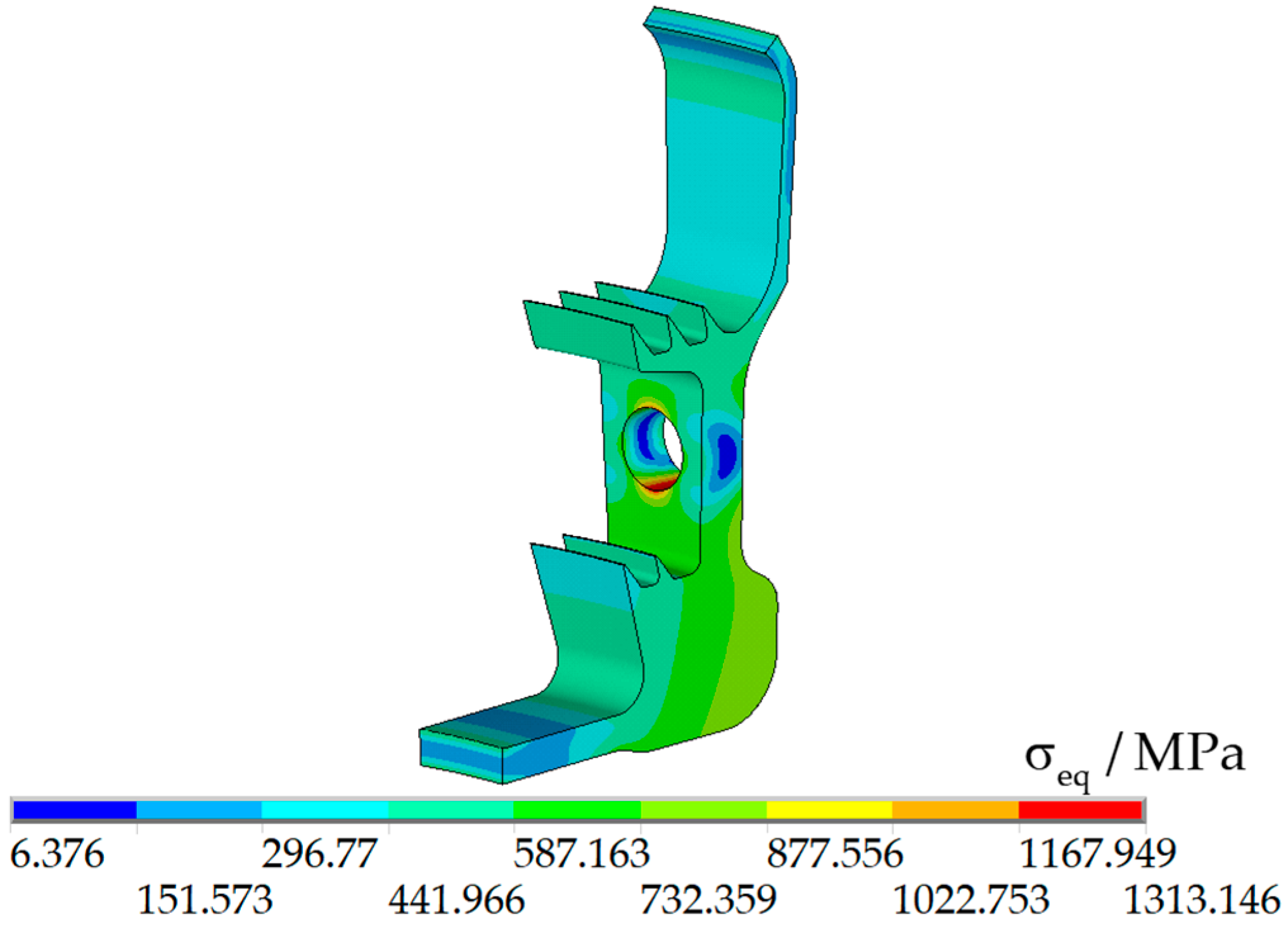

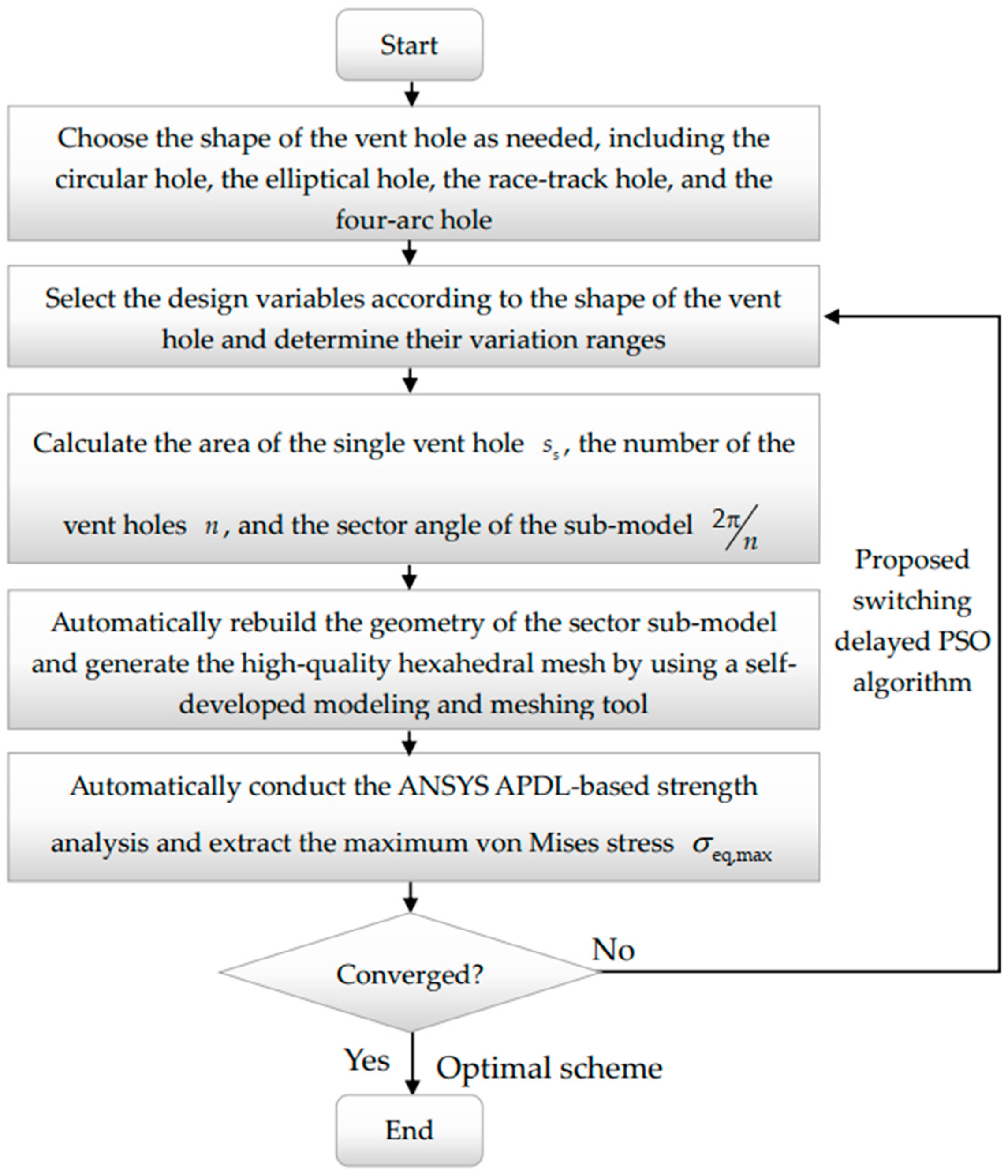
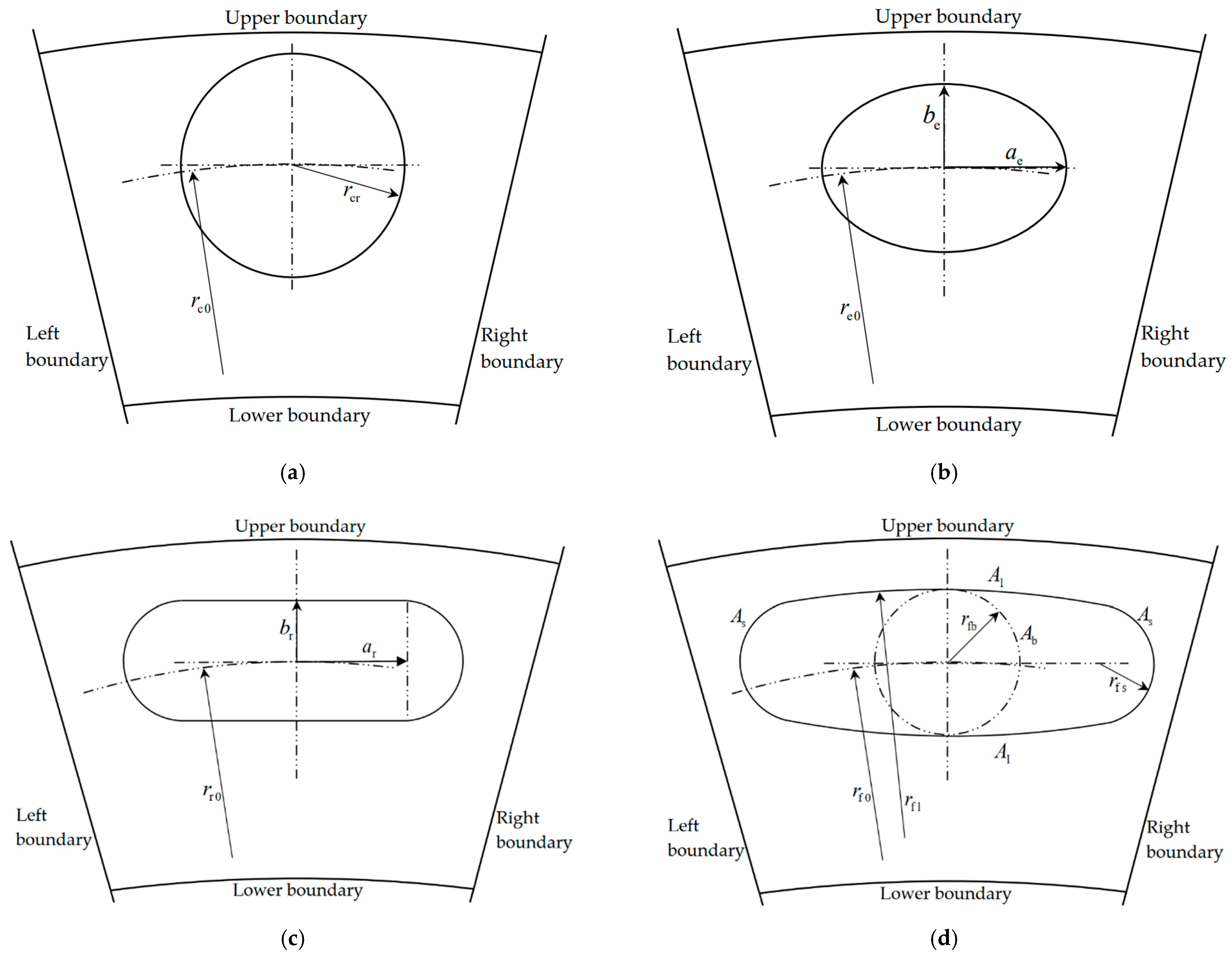


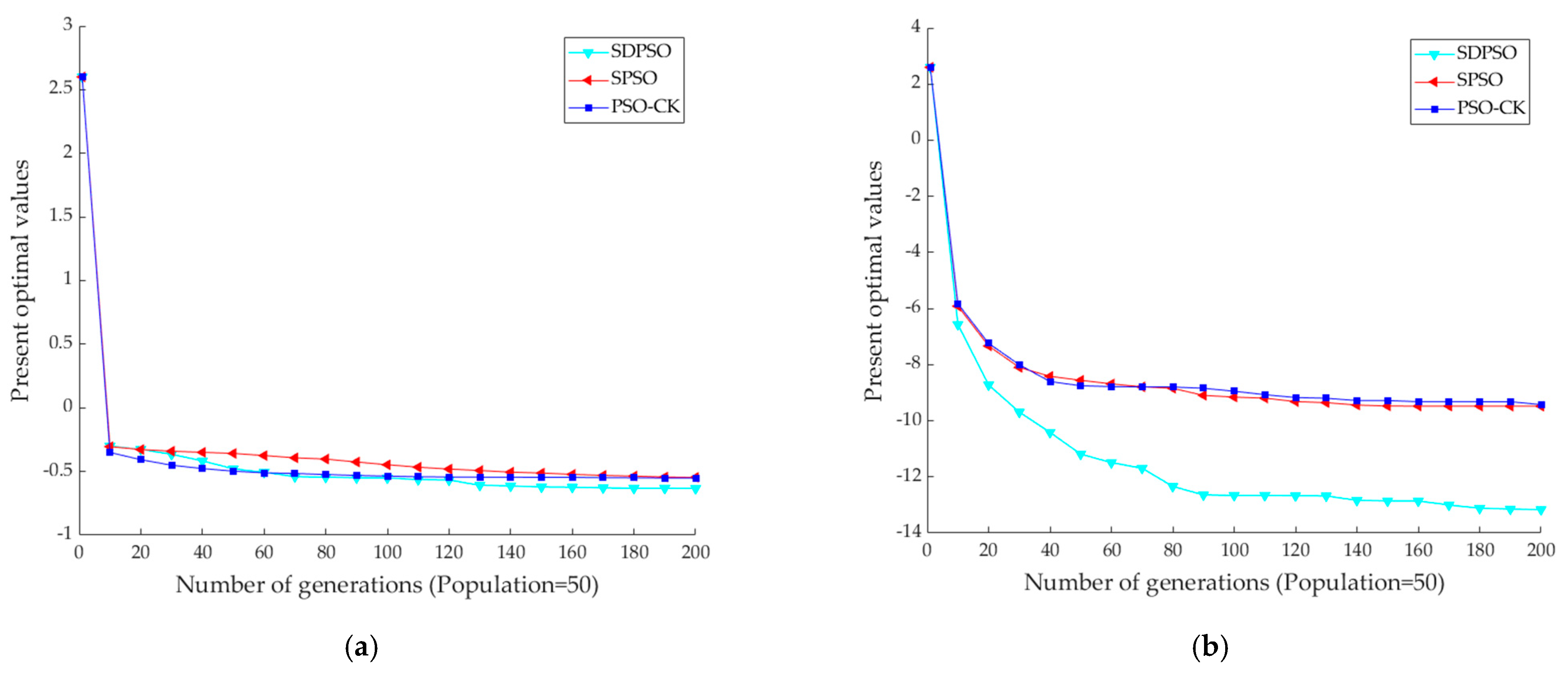
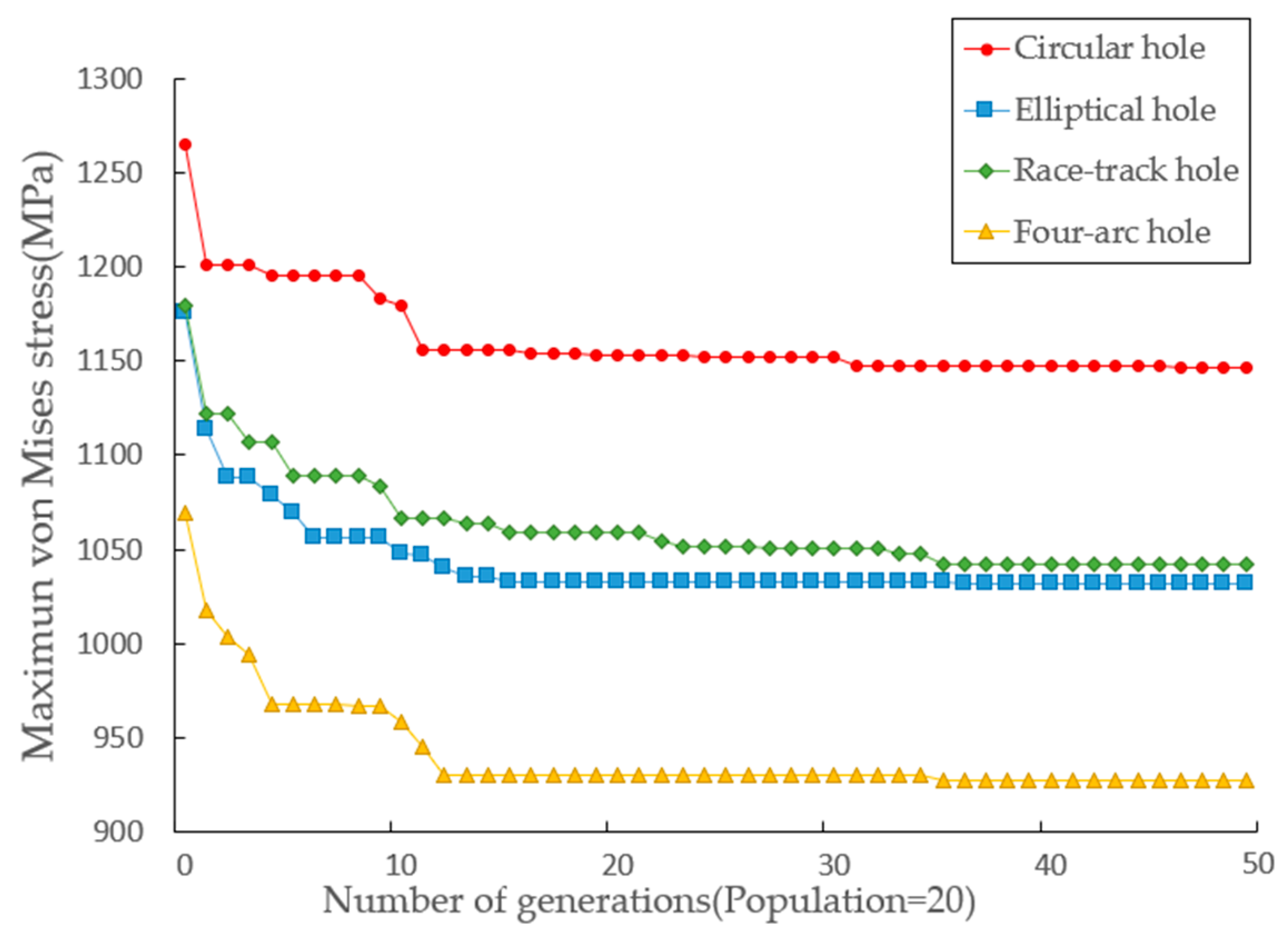
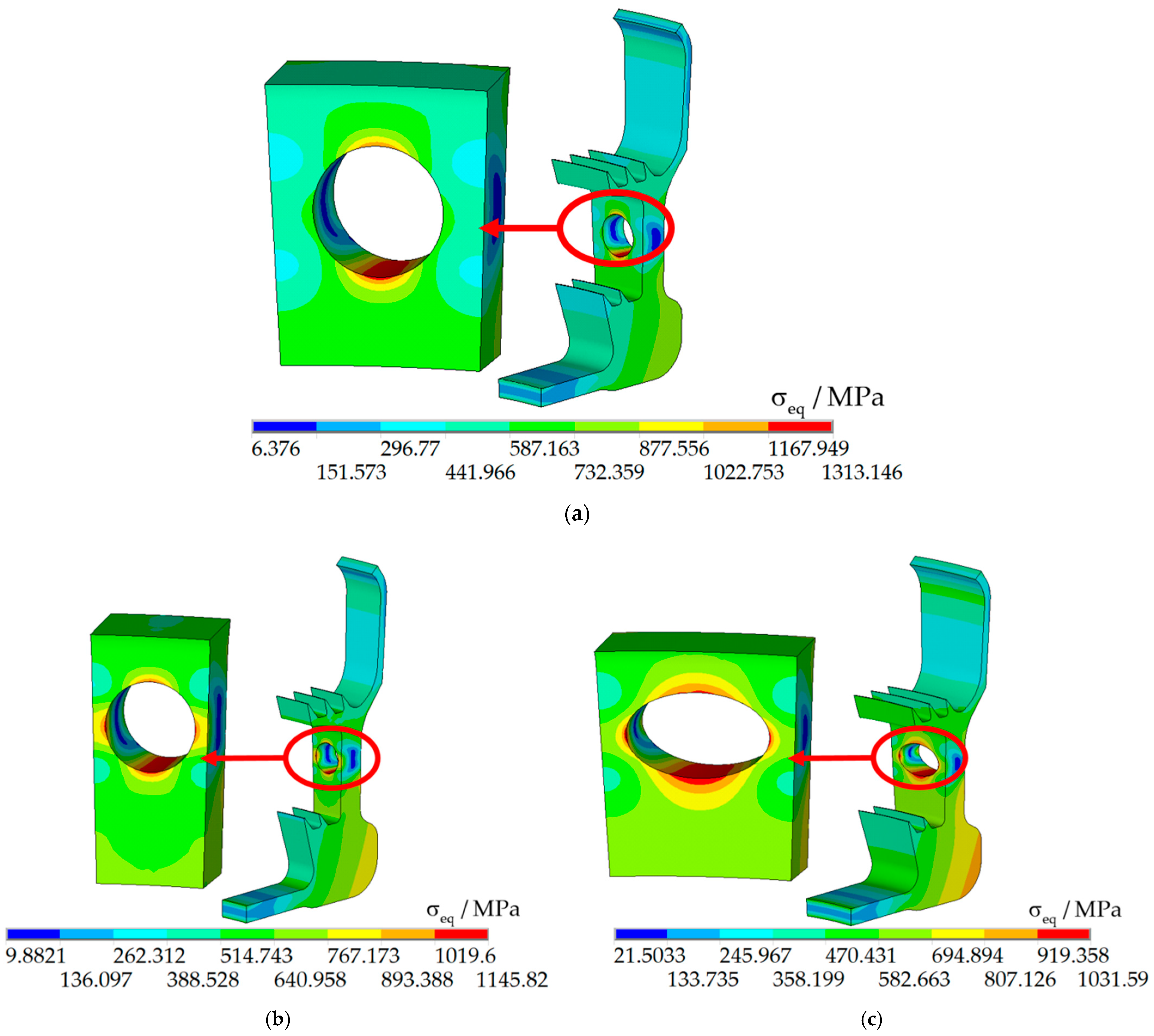




| State | Mode | ||
|---|---|---|---|
| Convergence | 2 | 2 | |
| Exploitation | 2.1 | 1.9 | |
| Exploration | 2.2 | 1.8 | |
| Jumping-out | 1.8 | 2.2 |
| State | Mode | pbest | gbest | ||
|---|---|---|---|---|---|
| Convergence | 0 | 0 | |||
| Exploitation | 0 | ||||
| Exploration | 0 | ||||
| Jumping-out |
| Problems | Criteria | PSO-CK | SPSO | SDPSO |
|---|---|---|---|---|
| BOP1 | Mean | −0.5513 | −0.5469 | −0.6344 |
| Minimum | −0.6675 | −0.6586 | −0.6684 | |
| Std.Dev | 0.0578 | 0.0602 | 0.0195 | |
| BOP2 | Mean | −9.4227 | −9.4800 | −13.1658 |
| Minimum | −12.00 | −12.00 | −14.4300 | |
| Std.Dev | 2.0889 | 2.0640 | 1.3983 |
| Schemes | Design Variables (mm) | Number of Vent Holes | Maximum Von MISES Stress (MPa) | Difference of Maximum Von Mises Stress | |||
|---|---|---|---|---|---|---|---|
| Initial circular scheme | --- | --- | 75 | 1313.146 | 0 | ||
| 5.800 | 225.360 | ||||||
| Optimal circular scheme | --- | --- | 124 | 1145.819 | −12.697% | ||
| 4.507 | 227.493 | ||||||
| Optimal elliptical scheme | --- | 66 | 1031.590 | −21.409% | |||
| 8.000 | 4.733 | 227.267 | |||||
| Optimal race-track scheme | --- | 90 | 1042.111 | −20.640% | |||
| 1.923 | 4.198 | 227.801 | |||||
| Optimal four-arc scheme | 56 | 927.395 | −29.376% | ||||
| 4.504 | 3.725 | 24.840 | 227.496 | ||||
| Schemes | Maximum (MPa) | Difference | Minimum (MPa) | Difference | Mean (MPa) | Difference | Range (MPa) | Difference |
|---|---|---|---|---|---|---|---|---|
| Initial circular scheme | 1272.098 | 0 | 556.080 | 0 | 818.125 | --- | 716.018 | --- |
| Optimal circular scheme | 1100.762 | −13.469% | 581.258 | 4.528% | 847.970 | 3.648% | 519.505 | −27.445% |
| Optimal elliptical scheme | 1031.590 | −18.906% | 674.632 | 21.319% | 859.042 | 5.001% | 356.958 | −50.147% |
| Optimal race-track scheme | 1042.111 | −18.079% | 683.831 | 22.973% | 858.025 | 4.877% | 358.280 | −49.962% |
| Optimal four-arc scheme | 927.396 | −27.097% | 779.550 | 40.187% | 858.501 | 4.935% | 147.846 | −79.352% |
Publisher’s Note: MDPI stays neutral with regard to jurisdictional claims in published maps and institutional affiliations. |
© 2022 by the authors. Licensee MDPI, Basel, Switzerland. This article is an open access article distributed under the terms and conditions of the Creative Commons Attribution (CC BY) license (https://creativecommons.org/licenses/by/4.0/).
Share and Cite
Yan, C.; Hao, W.; Yin, Y.; Zeng, N.; Du, H.; Song, D. Stress Optimization of Vent Holes with Different Shapes Using Efficient Switching Delayed PSO Algorithm. Appl. Sci. 2022, 12, 5395. https://doi.org/10.3390/app12115395
Yan C, Hao W, Yin Y, Zeng N, Du H, Song D. Stress Optimization of Vent Holes with Different Shapes Using Efficient Switching Delayed PSO Algorithm. Applied Sciences. 2022; 12(11):5395. https://doi.org/10.3390/app12115395
Chicago/Turabian StyleYan, Cheng, Wenkang Hao, Yiqi Yin, Nianyin Zeng, Han Du, and Dandan Song. 2022. "Stress Optimization of Vent Holes with Different Shapes Using Efficient Switching Delayed PSO Algorithm" Applied Sciences 12, no. 11: 5395. https://doi.org/10.3390/app12115395






